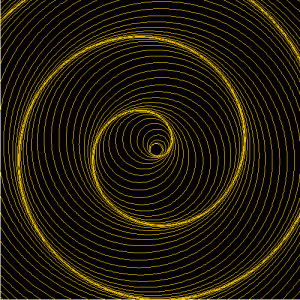
An academic scholar reviewing one of Sri Aurobindo’s writings made a critical remark that it is full of “monotonous repetition” of ideas. But the deeper cause or purpose of such repetitions has escaped the grasp of the critical mind of the scholar.
Any discerning reader of spiritual literature would have noticed a certain rhythmic repetition of ideas in most of the spiritually inspired classics, like for example, Bhagavad Gita. Sri Aurobindo writing on the thought-structure of the Gita, says: “…there is a wide undulating and encircling movement of ideas which is the manifestation of a vast synthetic mind and a rich synthetic experience”. Here is the clue to understand the deeper truth behind the rhythmic repetitions of ideas in intuitive thought.
The purely logical mind moves in a rigid, linear and logical sequence of thought. But the intuitive mind, which is in direct contact with the universal consciousness of Nature, follows the cyclic rhythms of Nature. For, the evolutionary process of Nature is not linear and sequential but cyclical. Ideas and motives progress in a certain repetitive rhythm, for example, an idea or motive which emerges at one point is developed a little more in the next stage, dropped or suppressed in the third stage, again taken up and developed further in a greater synthesis in the subsequent stages. The intuitive thought also, like the march of universal Nature, moves in such a cyclical and undulating rhythm.
We can observe this rhythm in the progress of thought in Bhagavad Gita. We will find that the same ideas are repeated again and again in different chapters. This is because in the intuitive thought-structure of the Gita, each chapter is an organic whole, a harmony of ideas and a particular perspective on a single subject, Yoga. Each chapter takes up an aspect, part or an idea of the whole, not in isolation, but in relation to other aspects (or ideas) and the whole. For instance, while in the second chapter the philosophy of Yoga is explained in terms of the values of the warrior temperament acting from the centres of will and vital force, in the third chapter it is viewed from the angle of a philosopher or sage, poised in his higher intelligence. Thus the thought of the Gita progresses in a pulsating and encircling rhythm, with each chapter synthesising the ideas discussed in the previous chapters with fresh inputs.
“Panoramic” is probably the right word to describe the march of intuitive thought. It is like a globe looking at itself wholly in various angles from different centres, and progressively synthesising the view-points as it rolls forward. However, this aspect of intuitive thought should not be taken as a rigid rule but as a general pattern which happens spontaneously during intuitive thinking. A rigidly logical mind may find such repetitive rhythms monotonous. But an intuitive mind understands, appreciates and enjoys it “as the return of a delightful rhyme”.
There is also a practical purpose served by these repetitions. It acts as what is called as manana in the Indian meditative practices. Manana means repeated dwelling of the mind on the idea. In the Indian Yoga of knowledge, sravana, which means “hearing” and manana are the first two stages in the meditative practices of the path. Thus, the rhythmic repetition of ideas act at once as sravana and manana, or, in other words, it induces meditation.





